How to Draw a Portrait With Hair How to Draw a Portrait Easy
If the thought of drawing hair overwhelms you - you're not alone. It's easy to see all of the details and textures within hair and assume that it must be difficult to capture it all in a drawing. But it doesn't have to be overwhelming and we can simplify the process, making drawing hair a bit more manageable.
In this lesson, we'll take a look at how to draw hair and I'll share with you a simple step by step approach of observation and application of media that can be applied to any type of hair.
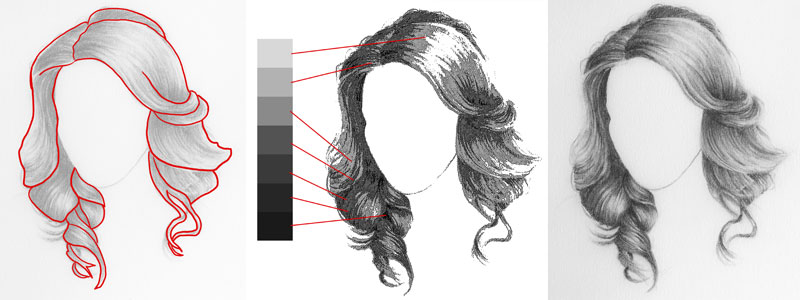
We'll first look at an easy to follow method that is broken down into 4 distinct processes...
Drawing Hair - The Four-Step Approach
I may be defining this process as a four-step approach, however it's more like a three-step approach. The third and fourth steps are combined and are executed at the same time. Before we begin the process of drawing the hair, we need to be sure that the structure of the head is drawn in place. The structure of the head dictates the shape and flow of the hair and should be defined before we begin drawing the hair.
Step One - Define the Outer Contour of the Hair
Assuming that the structure of the head is in place, the first step is to define the outer contour or outline of the hair. This includes the lines that are formed as the hair overlaps the forehead, portions of the face, and the shoulders. In many cases, the hair lifts off of the cranium and may overlap much of the face. Of course, every head of hair is different and the contours that are drawn at this stage will be different for every subject.
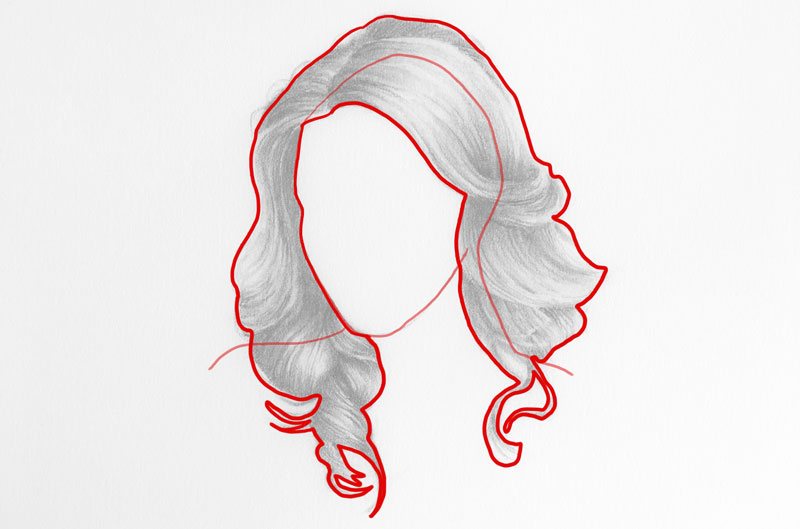
Tip: The medium that you use will influence how you approach drawing the hair. In this lesson, graphite pencils are used. For example, if you are drawing hair with pastels, you may choose to fill in the shape of the hair with solid color and skip drawing the contours.
We'll draw the contour lines lightly and loosely with a harder and lighter, 2H pencil. We're careful not to place too much pressure on this harder pencil as this can lead to indenting in the surface of the paper.
Step Two - Draw Shapes For The "Clumps" of Hair
As we draw the contour lines, defining the overall shape of the hair, we'll also draw smaller shapes for clumps of hair. Hair strands naturally collect and create a form (which is what I am referring to as a "clump").
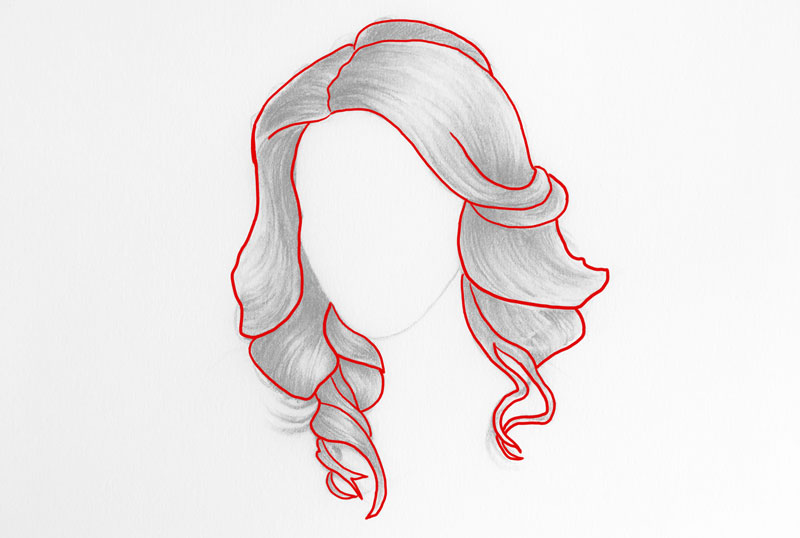
It clearly doesn't make sense to draw every strand of hair. Not only would this take an incredible amount of time to accomplish, but it also would lead to very unnatural looking hair. Instead, we need to consider the hair as a form. We'll define the volume of these forms in the next step, but for now we'll concentrate on defining the shapes.
Step Three - Developing the Volume Through Value
We understand forms because of the manner in which light interacts and behaves on them. We understand light through the use of value. Therefore, we understand forms in a drawing through the use of value. Value is the darkness or lightness of a color. The placement of dark and light values on a subject inform us of the intensity of light and the nature of the form.
We must consider the values and tones that are observed within the hair and include them in our drawing in order to communicate the volume of the hair. In most cases, a full range of value is present. This means that we're likely to find the darkest darks, the lightest lights, and the middle values all within a head of hair.
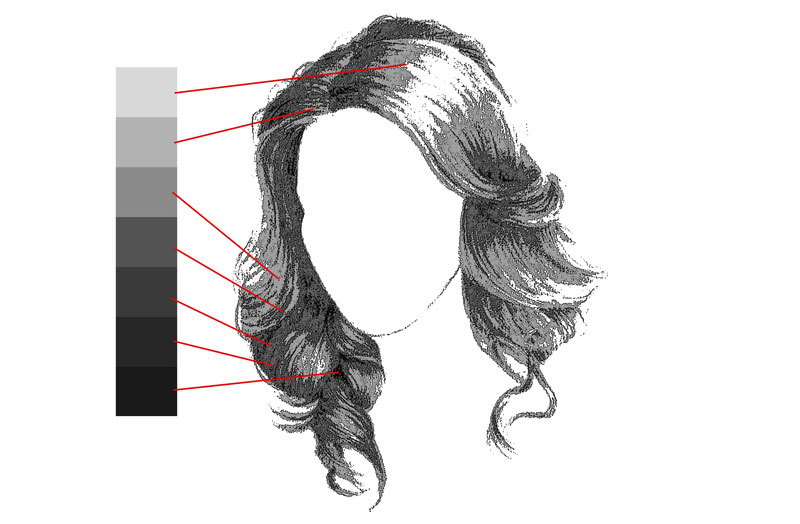
Because of the nature of light, we can assume a few things...
- Locations that recede will be darker in value.
- Locations that protrude will be lighter in value.
- No matter what the "color" of the hair, there will still be light and dark values.
We know that locations within the hair that are closer to the light source or extend out from the head are likely to "catch" more light. Naturally, this results in an area of lighter value.
We also know that areas that recede or are blocked from receiving light should be darker in value.
All hair colors will feature a full range of value. Blonds have locations of darker tone in their hair, and people that have black hair have areas that are almost white (highlights).
If we keep these things in mind, then we can assume that (in most cases) the parts of the hair and the areas around the face will be darker in value since these areas recede. We also know that highlights are most likely to be found on the top of the head, closest to a light source above.
To control the value fully, we'll start with a harder 2H pencil and develop the locations of darkest value, the mid tones, and the locations of light value. We'll do our best to preserve the areas of strongest highlight, allowing the white of the paper to do the work for us.
After the harder and lighter pencil is applied, we'll progress to a darker and softer one - addressing the areas of darkest value and tone. As we develop the value range and create the illusion of form, we'll also consider the texture.
Step Four - Draw the Texture of the Hair
(The texture of the hair is actually defined as the value is developed. So, the third and fourth steps of this process are addressed concurrently.)
Texture, like form, is also defined largely through the use of value. Light values and dark values work together to inform us of the texture of the subject. High contrast between values with little transition or gradation often leads to the illusion of coarse texture.
Smooth transitions between values with even gradations often leads to the illusion of a smoother surface texture.
But there is more to texture than the relationships of tone and value. The surface of the paper, the medium used, and the manner in which it is applied are all contributing factors as to how the texture of the subject may be perceived by the viewer.
Hair is soft, but there should be some indication of linear texture. To create the impression of linear texture, we'll apply the medium using directional strokes that flow over the form of each "clump" of hair. These lines are sometimes referred to as cross contour lines.
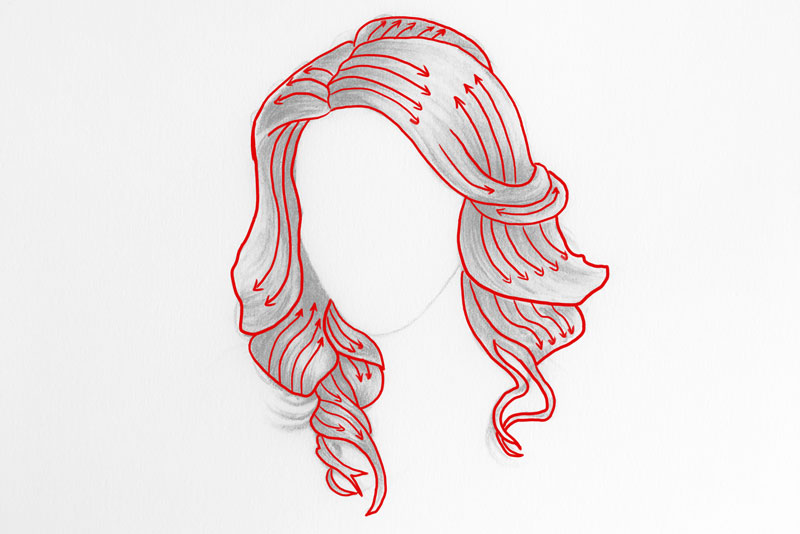
For each layer of graphite that we apply, we'll use a blending stump to work the medium into the tooth or texture of the paper. This will help to create the impression of softness and smooth any inconsistencies produced by the softer graphite applications.
Any locations within the hair that need to be lighter can be rendered using an eraser. An eraser pencil or eraser pen works best at lifting the graphite in these areas. Strands of lighter hair can be developed using the eraser as well.
To finish up, we'll add a few stray hairs that extend from the body of the hair. These stray hairs can be made with quick deliberate marks with a sharpened HB pencil.
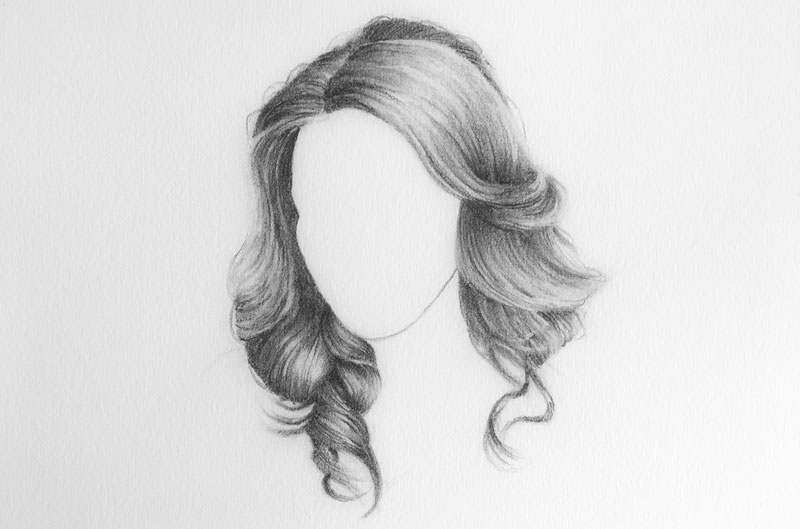
Hair is complex and is therefore complex to draw. But by breaking down the steps, we can simplify the process a bit. If you know how to see hair in terms of shapes, lines, and values then it becomes just like drawing anything else.
Drawing a Strand of Hair
As is the case with any subject that you draw, practice is important. The more that we practice with a particular subject, the better we understand it. Drawing a whole head of hair will give you lots of practice. However for some, the thought of doing this may be intimidating. Instead, it may be better to tackle a portion of the hair first. In this case, a single strand of hair will do.
You may start by taking a photo of someone's hair - perhaps your own. Try to isolate one portion of the hair. Look for a defined collection hair that forms a shape.
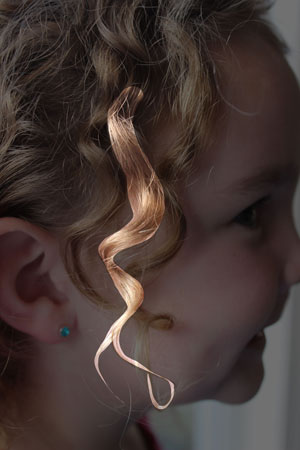
The four step approach that we explored above can also be used for a single lock of hair...
- Start by defining the shape with light, loose lines.
- Break the shape of the lock of hair down into simpler shapes.
- Look for the dominant shapes of light, dark, and middle values.
- Develop the texture and the value with directional strokes.
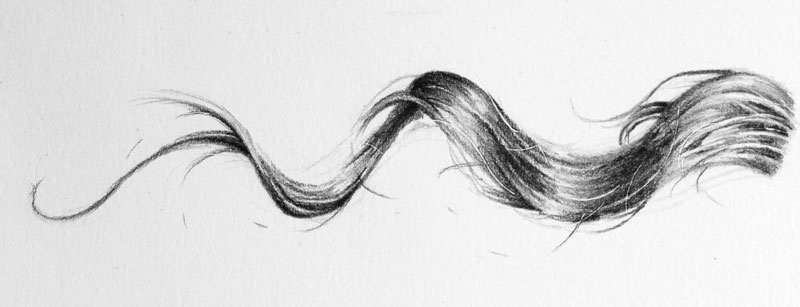
Drawing Straight Hair
In both of our first two examples, we saw how to draw hair that is wavy. But not everyone has wavy hair. So how is this process different if the hair is straight?
Well, it's not that different. In fact, we'll use the same approach to draw hair of any style. The only exception with straight hair is that we're likely to see less dramatic changes in value. We'll still see contrast between darks and lights, but this will happen from layering instead of within each "clump" of hair.
So again, we'll first define the outer contour of the shape of the hair. And again, we can simplify this further into smaller shapes that describe the clumps.
From here, we can look for the relationships of values. It may help to squint at your subject. Doing this may make the shapes of lighter and darker value stand out a bit more.

Then we'll use directional stroking to develop the texture and the range of value.
In the example below, a combination of graphite and white charcoal is used to develop the drawing. The drawing is completed on toned paper which makes the white charcoal applications stand out. The image below is from Portrait Drawing The Smart Way.
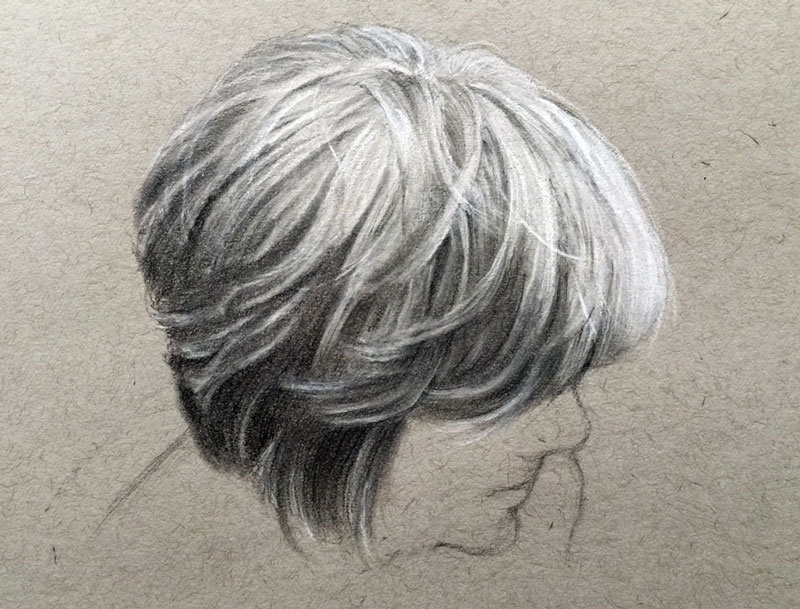

How to Draw Curly Hair
But what about curly hair? Shouldn't this type of hair be different?
Well, the results may be different, but the thought process is the same. We'll still need to start with the overall shape of the hair. Curly hair tends to have more stray hairs that find their way outside the confines of the general shape. For this reason, we'll concentrate on drawing the shape without all of the stray hairs. These stray hairs can be added after the general shape has been drawn, but more on this in a moment.
After the general shape has been defined, we'll consider the light source. In this case, the light source originates from the upper right corner. This produces highlights on the upper right portion of the head. Even though we have light areas here, we'll still see some dark values as well. This is true even if the hair is light in color.
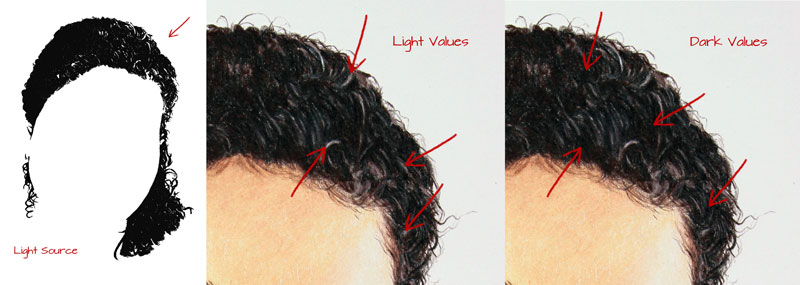
Once we have a good understanding of the light, we can begin developing the texture and value of the hair. The directional strokes that are used should flow along the form of each collection of hairs. With curly hair, the collections are smaller and more compact. Since the hair is curly, the directional strokes that we make for each "clump" should also curve just as the hair does.
Once we have the main body of the hair developed, we can go back and add those stray hairs. Doing this adds to the realism. Deliberate and confident marks work best for stray hairs. It doesn't have to be an exact copy of the subject, so don't put too much pressure on yourself to make it perfect.
Below you'll see the finished portrait drawing from The Colored Pencil Course along with close ups of the marks used for stray hairs.
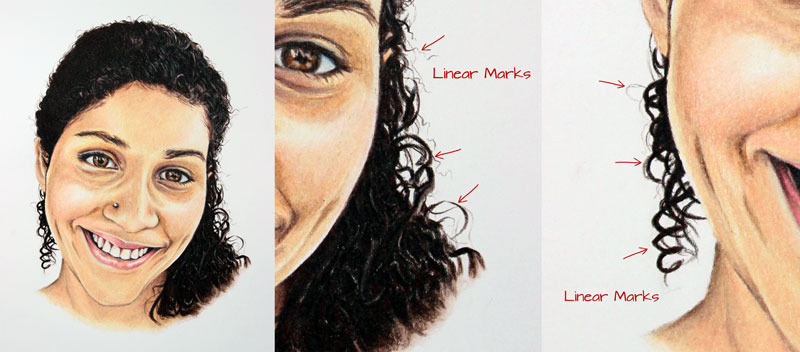
Different Approaches
There is no true formula for drawing hair. Every head of hair is unique and like many aspects of figure drawing, changes in viewpoint can dramatically affect the approach that you take. Light reflects off of hair differently and textures are diverse.
Observation is always paramount to your success no matter what approach you take or method you choose to use. There are always multiple "rights" and different ways of seeing.
Another Example - Step by Step
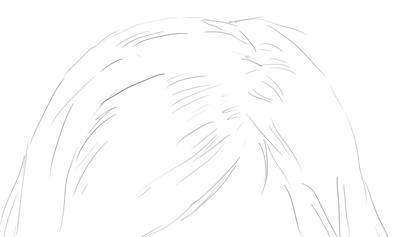
Begin by drawing the outline of the outside of the hair. Notice the dark areas and the light areas in the hair. Try to map out these areas as shapes. Don't try to draw every strand of hair. Instead, concentrate only on shapes and the value within them.
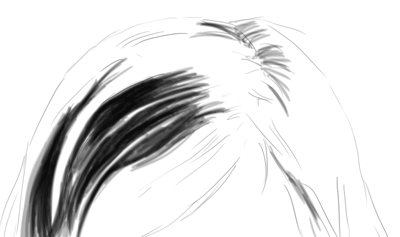
Next, begin to add value to the darker shapes first. You'll want to build up the value slowly. Be careful not to get too dark too quickly. Again, don't think about hair - think shapes, values, and lines.
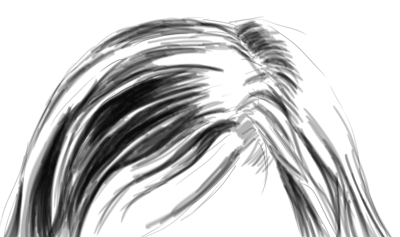
Continue darkening up the shapes and lines that you see. When you add directional lines in the hair, make sure that they flow in the direction that the hair grows.
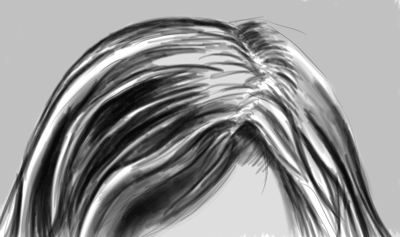
Contrast is important. Be sure to have a background value in mind. This will make your hair stand out.
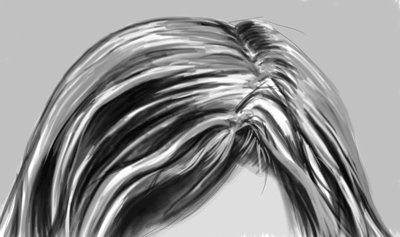
Don't be afraid to work the values to increase the contrast. Adjust darker tones by adding additional applications of graphite and make areas lighter with your eraser.
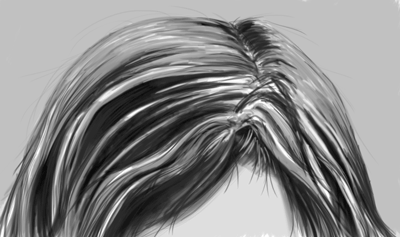
Be patient and understand that drawing hair is slow process. Take your time and allow the drawing to develop gradually.
More Lessons You'll Love...
Source: https://thevirtualinstructor.com/how-to-draw-hair.html
0 Response to "How to Draw a Portrait With Hair How to Draw a Portrait Easy"
Publicar un comentario